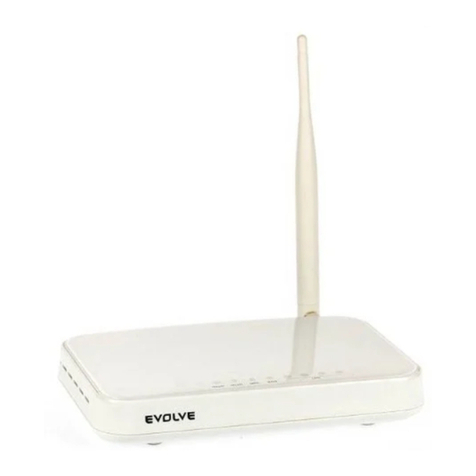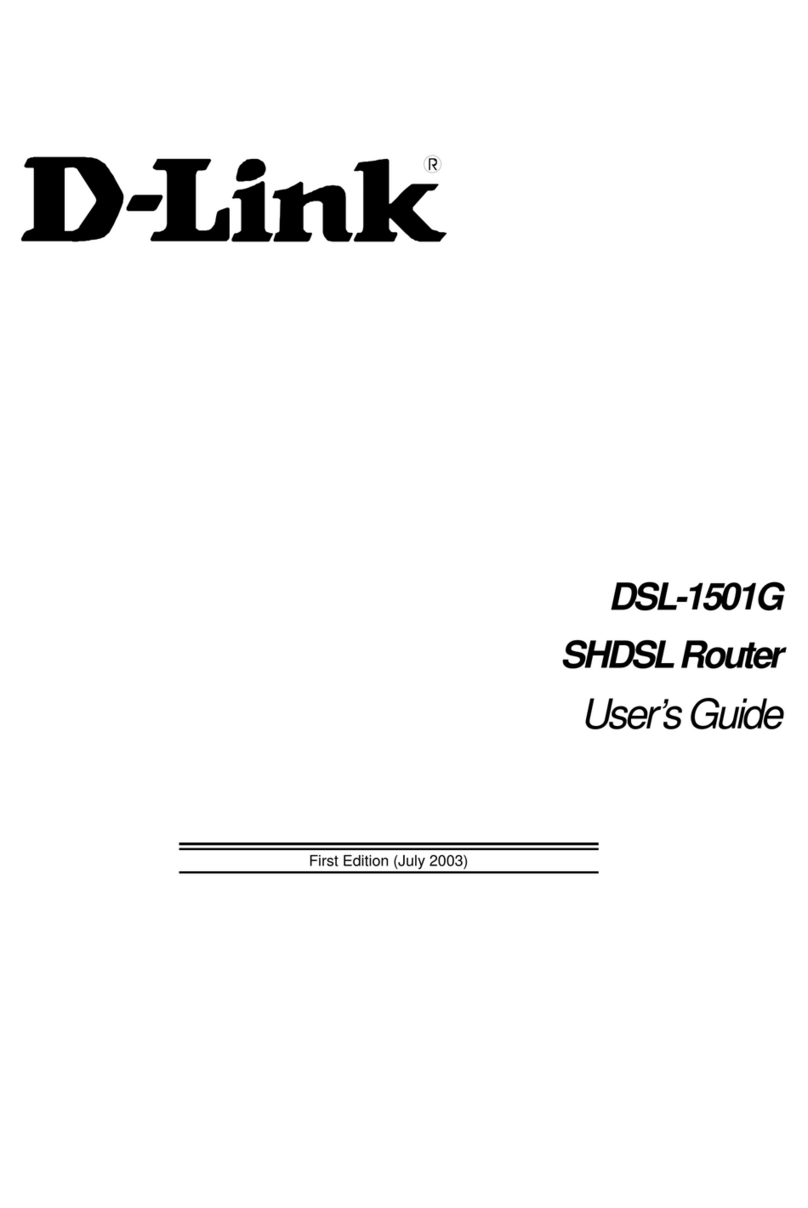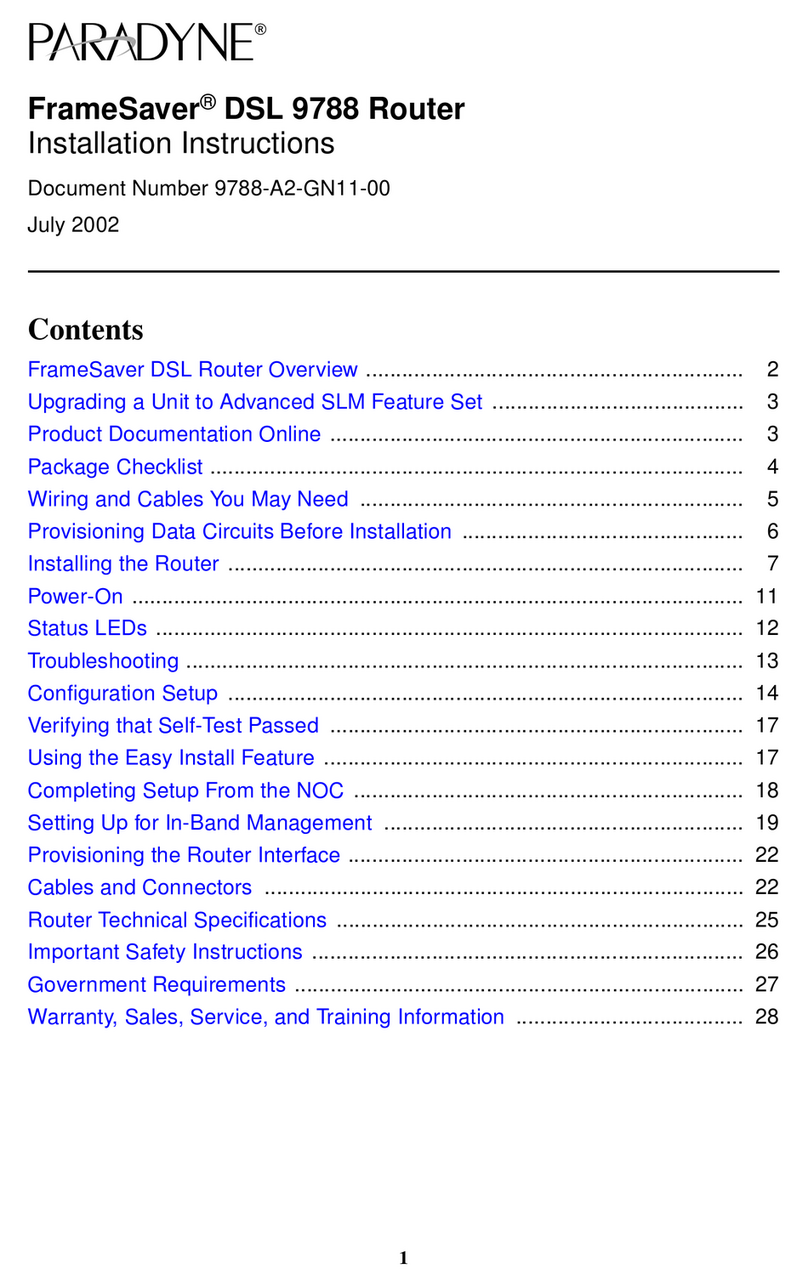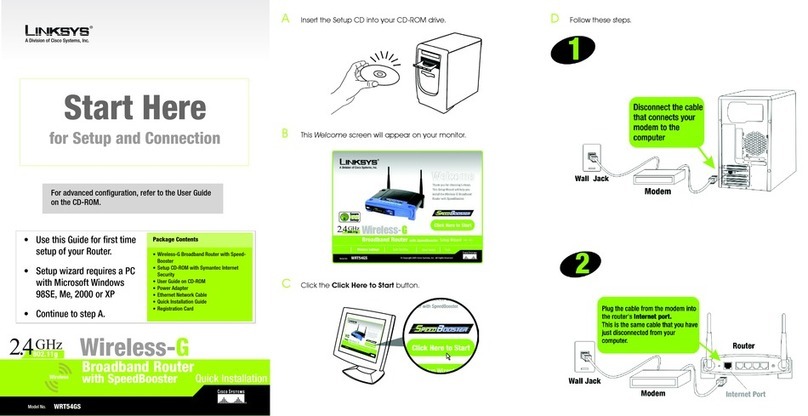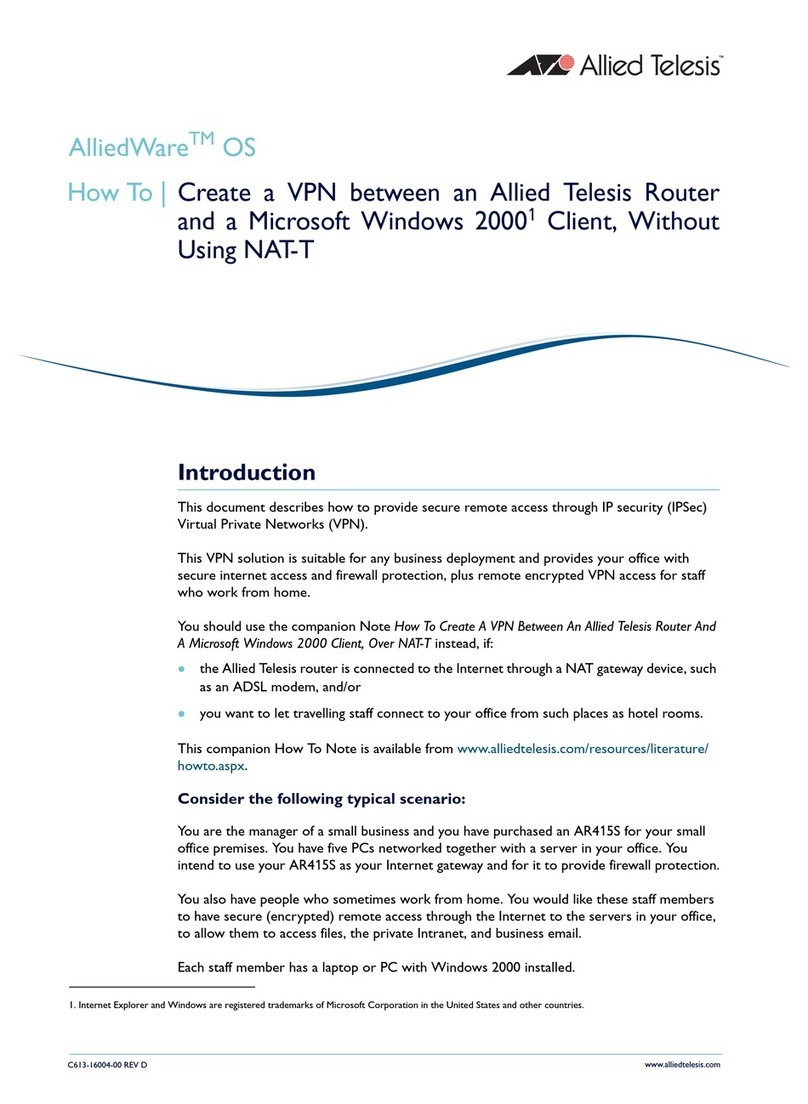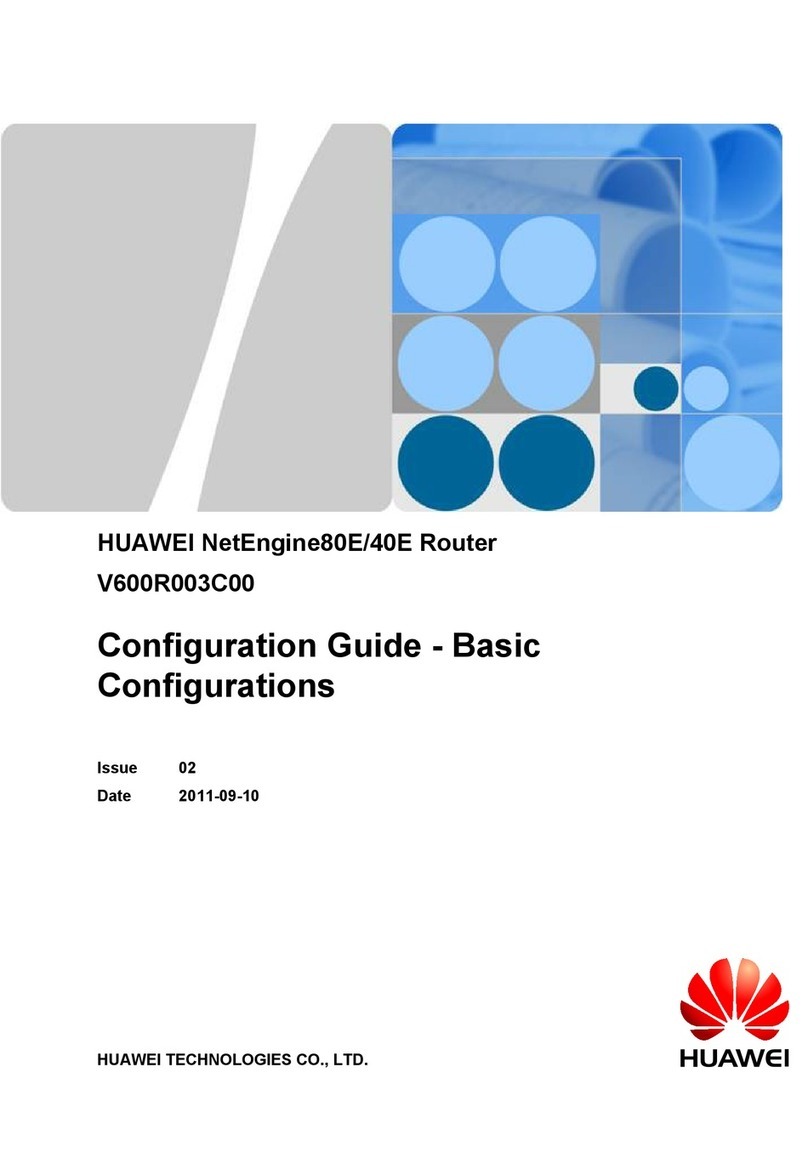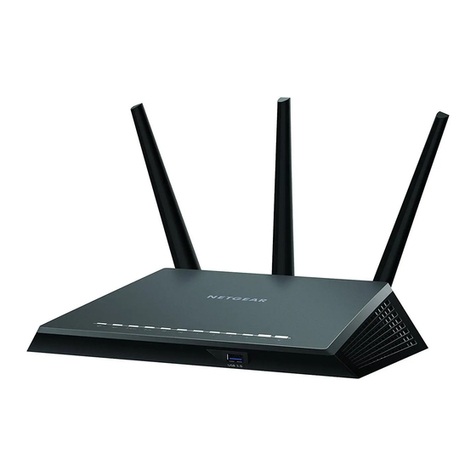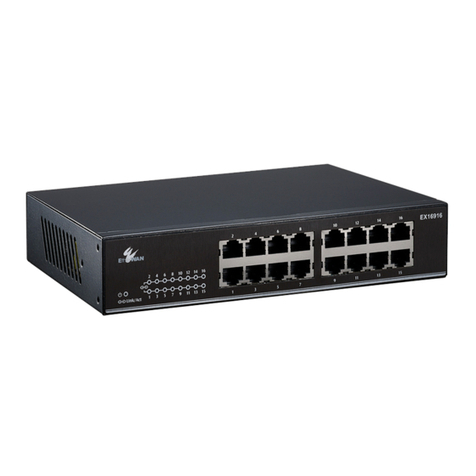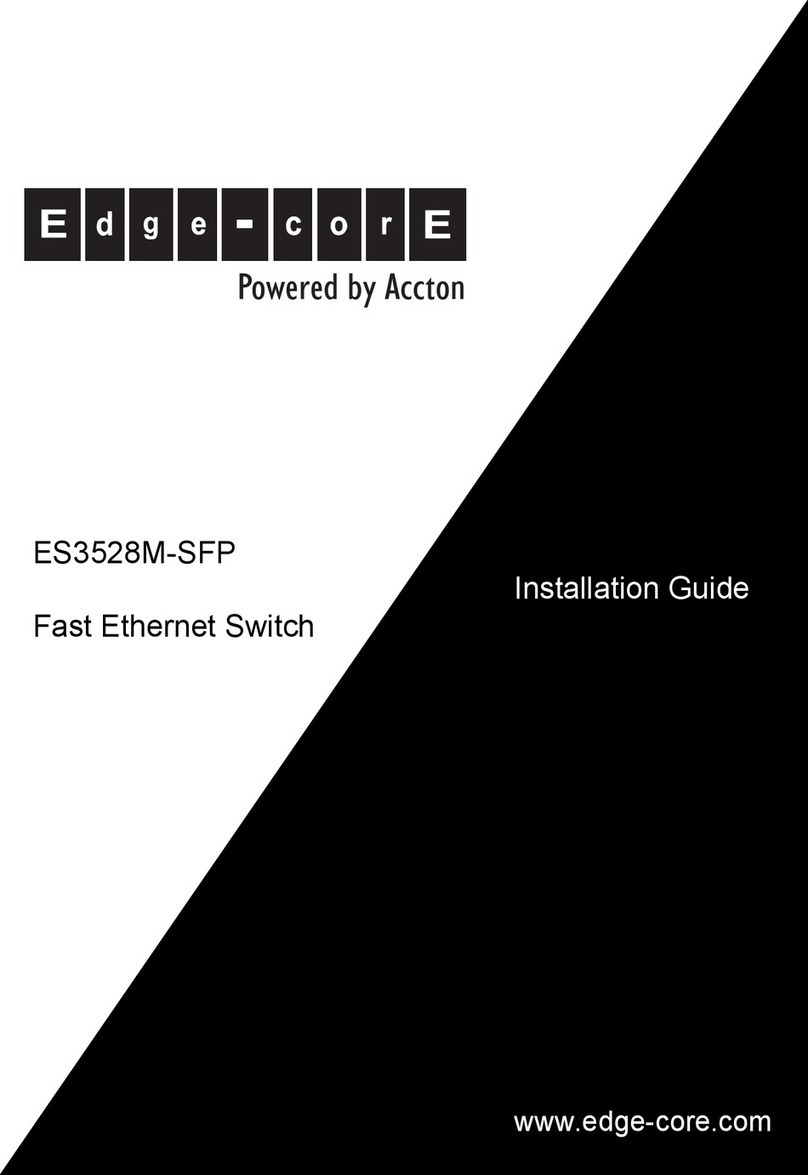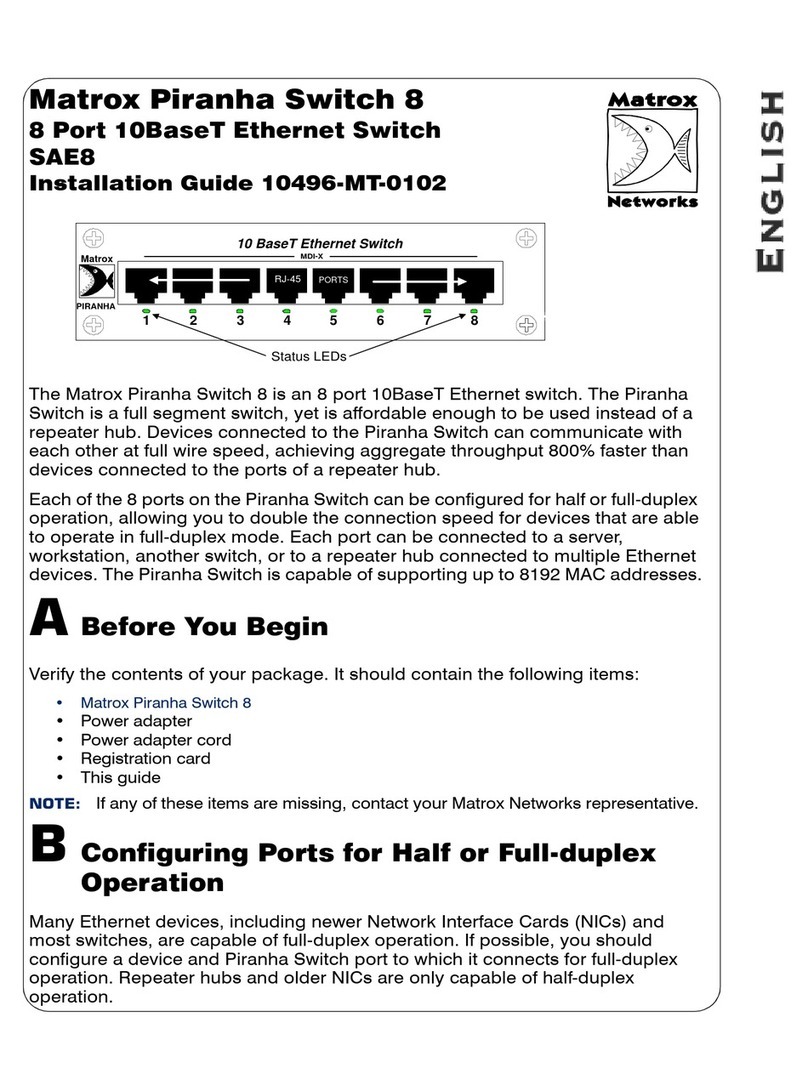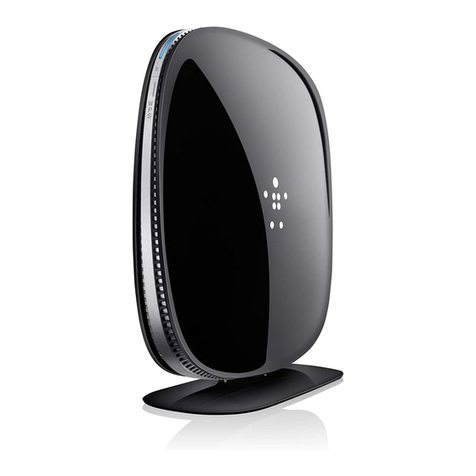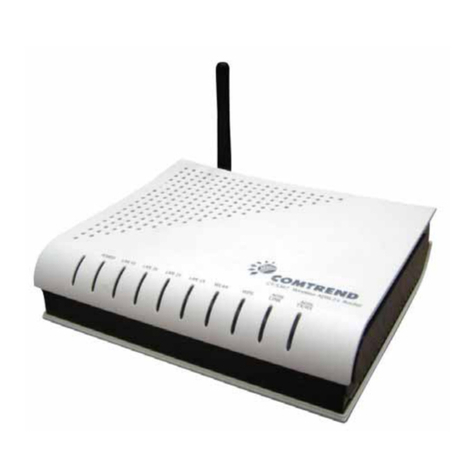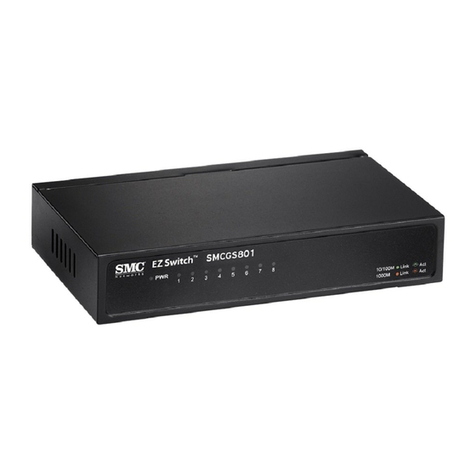ELITEL AH507 Series User manual

G.SHDSL Router – AH507
User’s Manual

G.SHDSL Router - AH507 Version 1.0
1
Table of Contents
1. PRODUCT OVERVIEW ..............................................................................................1
1.1
P
REFACE
......................................................................................................................... 1
1.2
O
VERVIEW
...................................................................................................................... 1
2. HARDWARE INSTALLATION....................................................................................7
2.1
F
RONT
P
ANEL
LED
S
I
NDICATORS
................................................................................. 7
2.2
R
EAR
P
ANEL
C
ONNECTORS
........................................................................................... 8
2.3
I
NSTALLATION
P
ROCEDURE
........................................................................................... 8
3. CONFIGURING WITH CLI..........................................................................................9
3.1
C
ONSOLE
S
ETUP
............................................................................................................. 9
3.2
M
ENU
O
VERVIEW
.........................................................................................................10
3.3
L
OGIN
........................................................................................................................... 10
3.3.1 Login.....................................................................................................................10
3.3.2 Changing System Password................................................................................ 10
3.4
S
ETUP
............................................................................................................................ 11
3.4.1 Main Menu ...........................................................................................................11
3.4.2 System Overview.................................................................................................. 12
3.4.3 System Operation Mode ...................................................................................... 12
3.4.4 Bridge Mode......................................................................................................... 13
3.4.5 Router Mode.........................................................................................................24
3.5
S
YSTEM
M
AINTENANCE
...............................................................................................50
3.5.1 Load Factory Default .......................................................................................... 51
3.5.2 General Maintenance.......................................................................................... 52
3.5.3 Ping Test...............................................................................................................53
3.5.4 Display Configuration......................................................................................... 54
3.5.5 Time Settings........................................................................................................ 55
3.6
P
ERFORMANCE AND
S
TATISTIC
.................................................................................... 56
3.6.1 DSL.......................................................................................................................57
3.6.2 ATM......................................................................................................................58
4. CONFIGURING WITH WEB......................................................................................59
4.1
L
OGIN
........................................................................................................................... 59
4.2
W
EB
M
ENUS
................................................................................................................. 59
4.3
S
ETUP
............................................................................................................................ 60
4.3.1 System Information.............................................................................................. 60
4.3.2 System Operation Mode ...................................................................................... 61
4.3.3 Bridge Mode......................................................................................................... 62
4.3.4 Router Mode.........................................................................................................70
4.4
M
AINTENANCE
.............................................................................................................93
4.4.1 General Maintenance.......................................................................................... 93
4.4.2 Time Settings........................................................................................................ 94

G.SHDSL Router - AH507 Version 1.0
2
4.4.3 Factory Default.................................................................................................... 95
4.4.4 Save....................................................................................................................... 96
4.5
P
ERFORMANCE
.............................................................................................................96
4.5.1 DSL Performance & Statistic.............................................................................. 96
4.5.2 ATM Performance & Statistic.............................................................................97
5. UPGRADING
FIRMWARE........................................................................................98
5.1
U
PGRADE USING
E
THERNET PORT
............................................................................... 98
5.2
U
PGRADE USING
S
ERIAL PORT
..................................................................................... 99
APPENDIX..................................................................................................................107
A
PPENDIX
A:I
NSTALL
TFTP
SOFTWARE
.........................................................................107

G.SHDSL Router - AH507 Version 1.0
1
1.1 Preface
The primary objective of this manual is to help network administrator operate AH507
bridge and router product. Strongly committed to user friendly, this manual will guide the
users step by step to turn the product up and running in the simplest way ever.
1.2 Overview
The AH507 is an ATM based G.SHDSL terminating device enabling the transport of
multi mega bits stream over one or two pair of copper wires using TC-PAM technology.
The unit complies with ETSI and ITU standard including G.991.2, allows full duplex and
operates at speed of 2.3 Mbps over 2-wire, and up to 4.6 Mbps over 4-wire loop. Based
on these standards, the AH507 is interoperable with the majority of DSLAM where
connections to the ATM core switches are made.
Each AH507 supports a wide range of protocols and features, including IP routing, point-
to-point protocol (PPP), ATM, frame relay, and standard bridging protocols. Embedded
with FRF.5 and FRF.8 Frame Relay to ATM Inter-working function, the AH507 thus
offers simultaneous connection of legacy Frame Relay equipment as well as routed IP
services to high speed ATM switch.
The port-based Virtual Server or host-based DMZ features allow local servers to be
exposed to the Internet for providing services such as File Transfer, Mailing, HTTP or
Telnet. In-built ACL (Access Control List) feature enables the unit to examine the
network traffic's Source IP address, Destination IP address, and IP protocol type to
decide if the IP traffic is allowed to pass through it.
Unlike simple Internet sharing device, the AH507 is a true firewall router, using stateful
packet inspection to defend against Denial of Service (DoS) attacks.
The VPN Pass Through feature supports the pass through of IPSec, L2TP or PPTP
tunnel for a secured transmission between two VPN endpoints
Remote management function allows user to be able accessing the AH507 via Web,
Telnet for configuration, or TFTP for firmware upgraded. It offers the embedded DHCP
server, which helps system administration manage the IP address network in the easiest
way ever.
1. Overview

G.SHDSL Router - AH507 Version 1.0
2
Features
SHDSL Access
Support 2/4 wires SHDSL and meet ITU-T G.991.2 standard.
ATM Protocols
ATM Multi-protocol Encapsulation over ATM Adaption Layer 5 (RFC 1483): Logical
Link Control (LLC) encapsulation routed modes
Virtual Circuit:
Terminates ATM Permanent Virtual Circuit (PVC) with ATM Adaptation Layer 5
(AAL5); Allows manual configuration of Virtual Path Identifier (VPI) and Virtual
Channel Identifier (VCI) for the full range of addresses supporting up to 12 Multiple
PVCs
Frame Relay Support
ANSI T1.617 and ANSI T1.618 Annex D LMI and Annex A LMI,
TCP/IP and PPP Support
IEEE 802.1d Transparent Bridging and Spanning Tree
TCP/IP with RIPv1, RIPv2 and static IP routing
PPP over ATM (RFC 2364), PPP over Ethernet, IP over ATM
Frame Relay (RFC 1490)
Network Address Translation (RFC 1631) DHCP Client, Server and Relay
DMZ support
Port Mapping/Forwarding
Security
Firewall with Stateful Packet Filtering
PAP and CHAP for PPP user authentication
Multiple IP SEC/L2TP/PPTP pass through
Protection against Denial of Service attacks
Configuration and Management
Management via local console, GUI, Telnet or embedded SNMP agent.
Software upgrade via TFTP/HTTP
Diagnostic Test includes DSL, OAM, Network Connection, Ping Test

G.SHDSL Router - AH507 Version 1.0
3
Network Interface
SHDSL Link
Standard:
SHDSL per ITU-T G.991.2
Line code:
TC-PAM, Support ANSI (ANNEX A) and ETSI (ANNEX B)
Data rates:
Automatic rate adaptive and manual programmable data rate
n x 64 kbps:
2.304 Mbps: 2-wire (line rate: 2.320 Mbps)
4.64 Mbps: 4-wire (line rate: 4.640 Mbps)
Connector:
RJ-11
Timing Source
Tx timing:
Note:CO fixed Internal clock
RT fixed Recovered clock
ATM Specification
ATM Adaptation: AAL5
AAL5 Encapsulation:
RFC 1483 "Multiple Protocol over AAL5"
RFC 2364 "PPP over AAL5"
ATM services:
CBR, UBR ,rt-VBR / nrt-VBR
F4/F5 OAM cells as per I.610
Frame Relay Support:
FRF.8 “Frame Relay/ATM Service Inter-Working
FRF.5 “Frame Relay/ATM Network Inter-Working
IP over Frame Relay

G.SHDSL Router - AH507 Version 1.0
4
User Interfaces
Data port
Termination: V.35
Rate: N x 64K bps
Protocol Support:
Frame Relay:
Transparent data over ATM AAL5
BVI: Bridge Visual Interface ( optional )
Tunneling: Optional HDLC encapsulation over IP (HDLC, or HDLC Cisco)
Clock source: V.35, Internal
Connectors: DB25, DCE
Ethernet Interface
Standard: IEEE 802.3 / IEEE 802.3u
Interface: IEEE 802.3/802.3u 10/100 Base-T
Bridging Capability:
Complied with IEEE 802.1d transparent bridge
Supports up to 128 MAC addresses learning
Supports bridge filtering function
Connection Type: : RJ-45
Management
Management Interfaces
Menu-base
Web-base
SNMP/Telnet
Management function:
LED status monitoring on DSL, V.35 and LAN.
Performance monitoring of DSL and ATM
Event (SNMP Trap)
Supervisory Port
Devices connected:
DCE port: ASCII terminal
Interface: V.24/RS-232, Async
Baud rate: Setting to 115.2 kbps, 8 data bits, 1 stop bits, on-parity
Connector: DB-9
Compliance
ITU-T: I.361, I.362, I.363, I.364, I.365.1, I.413, I.555, I.610

G.SHDSL Router - AH507 Version 1.0
5
FRF: FRF.5, FRF.8
Power
AC 100 to 230 VAC (Build-in AC Connector)
DC -42 to -56 VDC
AC+DC: AC 100 to 230 VAC, DC -42 to -56 VDC, field selectable
Ordering: AH507-i1-i2-i3
AH507-i1-i2-i3
i1
Specify the number of SHDSL loop
02
2 wires on SHDSL transmission
04
4 wires on SHDSL transmission
i2
Specify the V.35 FR Serial port
F V.35 Frame Relay
X No FR specified
I3 Specify the power source.
A AC power
D DC power
AD
AC+DC power

G.SHDSL Router - AH507 Version 1.0
6
ATM Switch
DSLAM
Transporting Frame Relay and IP traffic over ATM
Frame Relay Network
IP Network
DSLAM
Site 1
Frame Relay CPE
FR
IP
Site 2
Frame Relay CPE
FR
SHDSL 2
AH507
SHDSL 2
SHDSL
1
AH507
IP
ATM Core
ATM Switch
ATM Switch
Transporting Frame Relay over ATM
Site 2
FR Router
AH507
ATM Core
Site 1
Router
FR
AH507
IP on VC1
SNMP on VC 2
Legend: SNMP Stations
AH507

G.SHDSL Router - AH507 Version 1.0
7
2.1 Front Panel LEDs Indicators
There are eight LED indicators on the front panel of AH507. They show the statuses of
the device.
The functions of LED indicators are described in the following table:
LED Color Status Meaning
PWR
Green Steady
Off The device is on.
The device is off.
SYS Green Steady
Off The device is on and functioning properly.
The device is booting or Off
ACT Green Blinking
Off The device is sending or receiving data
There’s no data sending or receiving.
CO Green
DSL1
Green Steady
Blinking
Off
The device is Sync Status.
The link is synchronizing - this may take several minutes.
The device is unplugged or disconnected.
DSL2
Green Steady
Blinking
Off
The device is Sync Status.
The link is synchronizing - this may take several minutes.
The device is unplugged or disconnected.
LN1 Green Steady Link 1 – The LAN connection is successfully established.
LN2 Green Steady Link 2 – The LAN connection is successfully established.
LN3 Green Steady Link 3 – The LAN connection is successfully established.
LN4 Green Steady Link 4 – The LAN connection is successfully established.
TXD Green
RXD
Green
2. Installation

G.SHDSL Router - AH507 Version 1.0
8
2.2 Rear Panel Connectors
The rear panel connectors connecting the device to the LAN and xDSL network are
illustrated as follows.
2.3 Installation Procedure
Step 1. - Use RJ-11 cable to connect the device to DSL line.
Step 2. - Use MR34 to DB25 adaptor to connect the V.35 serial port.
Step 3. - Use RJ-45 cable to connect the device and the PC which has the Network
Interface Card (NIC) installed. If you want to connect to an external hub, you have to
use the RJ-45 cross-over cable.
Step 4. - Plug in the Power adaptor to the DC Power socket of the device, then connect
the Power adaptor to the AC outlet.
Reset
Power Adapter
110VAC / 220 VAC~5VDC
RJ-11
Phone Line
(Showing 2 wires SHDSL) 100/100M LANV.35 DB25
Figure 1: Rear Panel and Installation
-48VDC

G.SHDSL Router - AH507 Version 1.0
9
3.1 Console Setup
Step 1: Connect computer to the device through the console port as shown in Front
Panel.
Step 2: Open the terminal emulator software (like Hyper-Terminal on Microsoft Windows
machine, or “ Minicom” on Linux machine), then select the proper COM port for the
connection. Set the terminal and port to the following parameters:
- Terminal Mode: VT-100
- Baud rate : 115200 bps
- Data bits : 8
- Parity : None
- Stop bits : 1
- Flow Control : None
Turning on the AH507, then after few seconds of machine initialization, the system
management terminal will display the login screen. Details see section 3.3.1.
Figure 2: Console Setup
Emulator Terminal
VT-100
DSLAM / ISP
AH507
Corporation LAN
Internet
3. Configuring

G.SHDSL Router - AH507 Version 1.0
10
3.2 Menu Overview
You can refer to Main Menu, see section 3.4.1.
3.3 Login
3.3.1 Login
- Default Password: admin
3.3.2 Changing System Password
You can change the system password by following steps:
Login to the Main Menu:
Step1. - Press ‘E’ to open menu ‘System Maintenance’
Step 2.- Press ‘B’ to open menu ‘General Maintenance’
Step 3. - Press ‘C’ to enter the old password.
Step 4.- Press ‘D’ to enter a new password.
Step 5.- Press ‘E’ to re-type the new password to confirm.
Step 6. - Press ‘ENTER’ key to update.
NOTE: To cancel the setup, press the key ‘ESC’.

G.SHDSL Router - AH507 Version 1.0
11
3.4 Setup
3.4.1 Main Menu
It contains all the submenus of management system terminal in which the configuration
of device can be set.

G.SHDSL Router - AH507 Version 1.0
12
3.4.2 System Overview
From Main Menu, press ‘A’ to open menu System Overview.
In this menu, it shows the current system information such as: System Name, Model,
Firmware Version, CPU, RAM, Flash size, DSL chipset and Current Time.
3.4.3 System Operation Mode
You can set System Operation Mode: BRIDGE or ROUTER from two different menus:-
a. In menu ‘Quick Setup’:
From Main Menu,
Step 1: - Press ‘B’ - to open menu ‘Quick Setup’
Step 2: - Press ‘A’ - to select item Operation Mode
Step 3: - Press ‘Space Bar’ - to toggle between BRIDGE / ROUTER mode
Step 4: - Press ‘Enter’ - to update the system operation mode
b. In menu ‘System Setup’
From Main Menu,
Step 1: - Press ‘C’ - to open menu ‘Basic Configuration’
Step 2: - Press ‘A’ - to open menu ‘System Setup’
Step 3: - Press ‘A’ - to select item Operation Mode
Step 4: - Press ‘Space Bar’ - to toggle between BRIDGE / ROUTER mode
Step 5: - Press ‘Enter’ - to update the system operation mode

G.SHDSL Router - AH507 Version 1.0
13
NOTE: You must press ‘Enter’ to update system configuration after selecting the
operation mode.
3.4.4 Bridge Mode
In Bridge mode, AH507 provides frame forward services between two or more LANs. It
forwards frames based on the MAC (Medium Access Control) addresses which is
hardware-level of NICs (Network Interface Card)
The operation mode of the system must set to BRIDGE Mode. To change the mode,
please see the section 3.4.3. The following sections will help you to do configuration the
device in BRIDGE mode by using the system management terminal.
The application of the G.SHDSL Modem in Bridge Mode are illustrated in the following
figures
Figure
3
:
Bridge Mode
-
Application of
AH507
: Inter
net Access
Figure 4 Bridge Mode - Application of AH507: LAN-to-LAN
DSLAM / ISP
AH507
Corporation LAN
VPI/VCI
Bridge
IP Address
Internet
Bridge
IP Address Bridge
IP Address
Corporation LAN
Branch Office LAN
VPI/VCI
VPI/VCI
AH507
AH507
ATM

G.SHDSL Router - AH507 Version 1.0
14
3.4.4.1 Quick Setup:
From Main Menu, press ‘B’ to open menu ‘Quick Setup’
Using this setup, the device can be quickly configured and operated properly. The WAN
configuration is for the first Virtual Circuit ( VC 1 ) in twelve VC set available in the device.
The details of the items are described in the following table:
Item Field Name Description Value
A Operation Mode
System operation mode. Press ‘Space
Bar’ to select the setting.
BRIDGE /
ROUTER
Default: BRIDGE
Service Type System service type. System can be
operated as RT or COT type. Press
‘Space Bar’ to select the setting.
RT / COT
Default: RT
B
Standard Mode Physical standard mode. ETSI / ANSI
Default: ETSI
VPI Virtual Path Identifier, given by ISP. 0 - 16
C VCI Virtual Channel Identifier, given by ISP. 33 - 4096
D Bridge IP
Address The device IP address. i.e ‘192.168.0.2’

G.SHDSL Router - AH507 Version 1.0
15
3.4.4.2 Basic Configuration:
From Main Menu,
- Press ‘C’ to open menu ‘Basic Configuration’.
In menu Basic Configuration, the system can be configured in submenus: System Setup
and WAN setup.

G.SHDSL Router - AH507 Version 1.0
16
System Setup
From Main Menu,
- Press ‘C’ to open menu ‘Basic Configuration’.
- Press ‘A’ to open menu ‘System Setup’
In menu System Setup, it contains the system related configuration such as: operation
mode, service type, physical standard mode, Data Rate mode and so on.
The details of the items are described in the following table:
Item
Field Name Description Value
A Operation Mode System operation mode. Press ‘Space Bar’
to select the setting. BRIDGE / ROUTER
Default: BRIDGE
Service Type System service type. System can be
operated as RT or COT type. Press ‘Space
Bar’ to select the setting.
RT / COT
Default: RT
B
Standard Mode Physical standard mode. Press ‘Space Bar’
to select the setting. ETSI / ANSI
Default: ETSI
C Data Rate Mode Data transferred rate mode. Press ‘Space
Bar’ to select the setting. ADAPTIVE / FIXED
Default: ADAPTIVE
D* Range
Date rate range.
In Adaptive mode, the data rate can be
changed in the range 192~2304 kbps.
In Fixed mode, it is set in the range 64~2304
kbps. Press ‘Space Bar’ to select the setting.
ADAPTIVE: 192~2304
FIXED: 64 - 2304
E ETHERNET
Connectivity Specify the operation mode of LAN port. Auto-Negotiation/10M
half/10M full/100M
half/100M full
Note: * applicable for Data Rate FIXED mode only

G.SHDSL Router - AH507 Version 1.0
17
WAN setup
From Main Menu,
- Press ‘C’ to open menu ‘Basic Configuration’.
- Press ‘B’ to open menu ‘WAN Setup’
In menu WAN Setup, it shows the list of Virtual Circuits (VCs) and their statuses.
If a VC is already configured then it displays its name as a identification, otherwise it
displays a underscore line.
If a VC is already activated, then in the field ‘Active’, it displays the word ‘Yes’, otherwise
it displays a dash.
Table of contents

